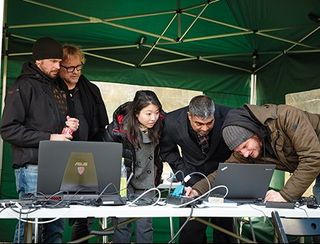Intel Opens Some Cover for Drone Operators

When the Federal Aviation Administration (FAA) debuted new rules for commercial drone operations on Aug. 29, the agency also granted more than 70 waivers to the new regulations, mostly centered on allowing broadcasters and other operators to use their drones at night.
But among the waivers was one that stood out, and could open up even more opportunities for news organizations looking to make drones a central part of their work. Namely, tech giant Intel was granted a waiver that not only allowed the company to operate drones at night, but also allowed for one pilot to operate multiple drones at the same time.
“We worked with the FAA…[to allow] for multiple drones per pilot, and the reason behind this was our light show [Drone 100],” said Natalie Cheung, Intel unmanned aerial vehicle (UAV) product manager.
Debuting in Tornesch, Germany last November (and in the process, setting a Guinness world record for most drones in the sky simultaneously), the seven- to eight-minute Drone 100 experience is paired with a live orchestra, with the drones flashing in sequence to the music. “We saw drones being used for inspections, for agriculture, for surveying and infrastructure, but what if we put an LED on a drone and launch it in the night sky? And then it was how do we put a hundred drones in the sky?” Cheung said.
“When we first started this experiment it looked amazing, and we wanted to expand it to get it approved in the United States,” she added. Intel worked with the FAA to acquire approval to test the Drone 100 experience for the first time stateside, with a twilight showing at a private event in Palm Springs, Calif., in March. Also in June, Drone 100 was seen for five consecutive nights in Sydney, where they took off from barges in the Farm Cove inlet, and were witnessed by more than 100,000 spectators.
Receiving the FAA waiver wasn’t easy: it helped that Intel had already received an exemption to the new FAA drone rules, but “we have a huge safety checklist to abide by, to ensure the drones never [wander],” Cheung said. “We’ve proven that it works, multiple times. Our system is safe, and it works.”
And the multiple drones waiver could open up opportunities for broadcasters and other commercial operators, she added—multiple drones checking on traffic, covering major outdoor events and sports coverage all come to mind.
Broadcasting & Cable Newsletter
The smarter way to stay on top of broadcasting and cable industry. Sign up below
“The intention was just for light shows, but there are a lot of possibilities behind it, operating multiple drones with one pilot,” Cheung said. “It can make operators more effective and more efficient, collect more data quickly, and it’s all controlled by a computer, instead of manual operation, making for less room for human error.”
Currently, Intel is working closely with government officials to open up more opportunities for commercial drone operations, with new technologies that allow drones to self-navigate around objects, and on-board technologies that capture data from multiple angles. In early August, Intel CEO Brian Krzanich along with Anil Nanduri, the company’s head of drones, addressed the White House Office of Science and Technology Policy to offer their thoughts on both public and commercial usage of drones.
The new drone rules adopted by the FAA still require drones to be in the line of sight of operators at all times, but there are lessened restrictions on the training operators need to acquire to fly them. They also allow broadcasters to fly drones near crowds for the first time. The new rules apply to drones 55 pounds and under.
